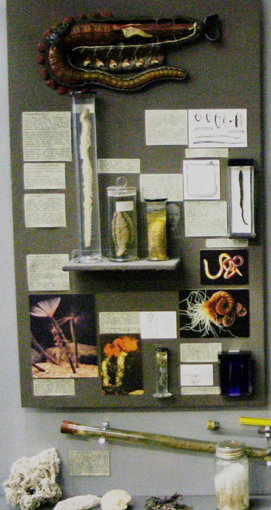
PHYLUM ANNELIDA
The Phylum Annelida is one of the three major invertebrate phyla, which have successfully evolved on land as well as in the sea. Polychaetes comprise just over 5000 species of marine worms, the 3000 species of oligochaetes mostly live in terrestrial and fresh water habitats and over 500 species of leeches inhabit marine, freshwater and terrestrial habitats. Annelids have solved the problem of controlling a long, thin body by dividing it into similar parts or segments arranged serially one behind the other. Segments are formed from internal walls or septa, which divide the coelom into compartments. Each segment contains its own set of muscles, nerves, blood vessels and excretory organs. The segments are marked externally by grooves in the body wall. The head region controls the body and movement is governed by nervous impulses moving from segment to segment and stimulating sequential contractions of the muscles. As annelids do not have a waterproof exoskeleton, on land they can only survive in aquatic habitats or as burrowers in damp soil.
There are three classes of annelids:
- Class Polychaeta: marine annelids;
- Class Oligochaeta: marine, freshwater and terrestrial annelids including earthworms;
- Class Hirudinea: marine, fresh water and terrestrial leeches.
Both polychaetes and oligochaetes are food for a variety of animals. Marine worms are eaten by invertebrates, such as echinoderms and molluscs, as well as by fish and shore birds. Earthworms are food for birds as well as moles that store them in special larders. Scottish earthworms may also fall prey to an immigrant flatworm from New Zealand that wraps itself around the worm and pours out digestive juices. After a few hours the flatworm can then feed on the decomposing earthworm.
Our specimens reveal the versatility of the simple annelid body plan and show how members of the three classes have adapted to a variety of aquatic and terrestrial habitats.
The relationship between annelids and arthropods
Annelids share some features with arthropods – both groups are triploblastic, schizocoelous, segmented protostomes with a tubular gut and posterior anus. It seems likely that both evolved from an early ancestral polychaete. The differences in reproductive behaviour and parental care shown by living marine and land annelids must have arisen as the first annelids moved from an aquatic environment into terrestrial habitats. These behavioural differences were probably the precursors of the marked differences in parental care exhibited by marine and land arthropods.
|
||||||||||||||||||||||||||||||||||||||||||||||











